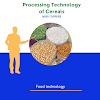MEAT AND POULTRY PLANT SANNITATION
INTRODUCTION
Meat and Poultry are perishable food stuffs, and red meat has relatively unstable color.Poor sanitation practices increase microbial damage resulting in reduced color, flavor, and product safety. Effectivesanitation is essential to reduce discoloration, spoilage and pathogen growth with the resultant increase in shelf life product safety. Sanitation in meat and poultry industries requires good housekeeping, beginning with live animal or bird and continuing through serving prepared product the sanitation practice should be thoroughly planned, actively enforced and effectively supervised. The most successful program involves inspection by trained person, who is responsible for sanitary conditions of plant and equipment
Role of sanitation
Method of processing and distribution of meat and poultry products are responsible for increased exposure to microbial contamination. Improved sanitation is responsible for reduced contamination and increased product stability. Reasons for maintaining high standard of cleanliness in meat and poultry facilities: these products are vulnerable to attack by microorganisms present under unsanitary conditions. microorganisms cause product discoloration and flavor degradation.Self service merchandising of aerobically packed fresh meat and poultry place a premium on intensive sanitation to increase shelf life.
MEAT AND POULTRY CONTAMINATION
During the slaughter, processing, distribution, and food service cycle ,food items are handled frequently, Because almost anything coming in contact with meat and poultry can serve as a source of contamination.When alive, a healthy animal possesses defense mechanisms against microbes. After slaughter this natural defense breaks down, if the handling is careless and ineffective it is effected by microbial growth.Sticking knives contaminated with bacteria introduces contamination through wound. An animal’s heart may beat 2-9 minutes after sticking, thereby permitting the distribution of microbes.Unwashed animals have approximately155 million microorganism/cm² of skin where the jugular vein is cut.Contamination during evisceration of animals is increased because the stomach and intestinal contents are loaded microbes. A major contamination source for meat in the slaughter house is rumen fluid, which averages 1.3 billion microorganisms per mlcarcass surface counts of 300 to 3000/cm² microbes on average. Beef and pork trimming contain 10,000 to 500,000 bacteria per gram.Depending on contamination and sanitation practices, cutting boards on fabricating approximately 77,500 bacteria per square centimeter. Slicers conveyors, and packaging equipment may increase the contamination of processed meat by 1000 to 50000 bacteria per gram, depending on sanitation practices.
PATHOGEN CONTROL
Highly contaminated parts should be trimmed to lower the microbial loadfreezing is known to reduce campylobacter populations, also by ice-crystal damage to cells and by Dehydration.Psychotropic pathogens like Listeria monocytogenesis can survive at 0°c storage environment. Doyle has suggested that use of antimicrobial agents, reduced temperature(<2°c) storage, reformulation of products(reduced minimum water activity, pH etc), or post process pasteurization can control such pathogens.Alkaline and neutral cleaning compounds, sodium hypochlorite, acidified sodium chlorite, peroxyacetic acid, octanoic acid mixure and quaternary ammonium compound sanitizing agent.Employees who work in raw and finished product areas such as smokehouses and water and steam cooking areas, should change outer clothing and sanitize their hands when moving from raw to finished areas.Utensil and thermometers that are used for raw and finished products should be sanitized each time they are used. Frequent cleaning with floor scrubbers is essential.
LAYOUT AND PLANT DESIGN
Plant layout should prevent pests and vermin and should control movement of L. monocytogenes between raw and cooked product areas.Air and refrigeration equipment should be designed for easy cleaning and sanitizing. Ready-to-eat areas should have a positive air pressure design.All equipment and other surfaces should be easily cleaned and sanitized with smooth, nonporous surfaces. Floor should be surfaced with materials that are easily cleaned and will not encourage water accumulation.Prevent proliferation in growth niches or other sites that lead to ready-to-eat product contamination.
CLEANING COMPOUNDS OF MEAT AND POULTRY PLANTS
Acid cleaners
Strongly alkaline cleaners
Heavy-duty alkaline cleaners
Mild alkaline cleaners
Neutral cleaners
SANITIZERS FOR MEAT AND POULTRY PLANTS
Steam
Chemical sanitizer:
Sodium and calcium hypochlorite
Liquid chlorine
Chlorine dioxide
Active iodine
Ammonium compounds
Acid sanitizers
Ozone
SANITATION PRACTICES
Workers should ware freshly laundered clothes ad stay away from meat and other processing equipment if they are ill.Cleaning and sanitizing compounds should be kept in an area accessible only to a sanitation supervisor, manager, and superintendent and should be allocated only by the sanitation supervisor. Misuse may inhibits effectiveness of these cleaning compounds.Cleaning compounds should be applied according to the instructions or recommendations provided by the venders.Sanitation supervisor should inspect all areas.All soiled areas should be recleaned prior to the morning inspection by the regulatory agency.
LIVESTOCK AND POULTRY TRUCKS: Immediately after removing livestock and poultry from trucks, scrape and remove all manure that has accumulated from the premises.
LIVESTOCK PENS: After the livestock are taken from each pen, clean the manure from the floors and walls, and remove it from the plant premises.
SLAUGHTER AREA:
Pick up all large pieces of extraneous material and transfer the matter to receptacles.cover all connections with plastic sheeting.Briefly prerinse all soiled areas with 50-55°c water, then apply cleaning compounds, within 20 min rinse ceilings, walls,equipments.
RECEIVING AND SHIPPING AREA: similar to slaughtering area
PROCESSED PRODUCTS OFFAL AND STORAGE COOLERS: clean each section with reliable cleaner, rinse thoroughly with 55°c water at high pressure within 20min. Squeegee the floor where water has accumulated to prevent it from freezing. Remove clean and replace drain covers
PROCESSED PRODUCT PACKAGING AREA: Cover packaging equipment, motors, outlets, scales, controls and other equipment with plastic film. Prerinse all surface with 55°c water to remove heavy debris and soak exposed surfaces, apply alkaline cleaner using same temperature water, then rinse the area within 20-25 min















0 Comments
Send feedback